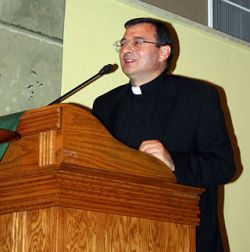St. Faustina's legacy leads faithful to deeper love of God

MAGNA — "Man will not have peace until he turns to God with trust," Marian of the Immaculate Conception Father Kazimierez Chwalek said in opening his presentation on St. Faustina and the Divine Mercy devotions Sept. 16 at Our Lady of Lourdes Church in Magna. "Fr. Kaz," as he is known, visited Our Lady of Lourdes Parish, Magna and St. Martin de Porres Parish, Taylorsville, to spread the message of the Divine Mercy devotions as written in the diary of St. Faustina, subtitled, "Divine Mercy in my Soul," which Fr. Kaz helped translate from Polish to English. "In her diary St. Faustina tells us that we need God’s powerful grace; we need to deepen our relationship with God in order to find harmony and peace. We need the grace that flows from Christ." We can obtain the powerful grace of which St. Faustina wrote, Fr. Kaz said, by practicing devotions to the Divine Mercy as revealed by St. Faustina. Perhaps most familiar to Catholics is the image of the Divine Mercy, a painting of Jesus as he appeared to Sr. Mary Faustina Kowalska, a member of the Sisters of Our Lady of Mercy. On Feb. 22, 1931, Our Lord appeared to Sr. Mary Faustina in her convent outside Kracow, Poland. He asked her to paint his image as he appeared to her, dressed in a white garment, his right hand raised in blessing and his left hand at his breast. Emanating from his heart were two rays, a red ray, symbolizing his blood of sacrifice, "the life of souls," and a pale ray, signifying water, "which makes souls righteous." The whole paschal mystery captured in one image, Fr. Kaz said. Faustina wrote: "Jesus looked at me and said, "souls perish in spite of My bitter Passion. I am giving them the last hope of salvation (recourse to My Mercy). If they will not adore My mercy, they will perish for all eternity. Secretary of My mercy, write, tell souls about this great mercy of Mine, because the awful day, the day of My justice, is near." Sr. Mary Faustina followed Jesus’ instructions. Not an artist, she had the image painted under her direction. In subsequent appearances to her Jesus would reveal special prayers and devotions, including the Divine Mercy Chaplet, a series of prayers recited on a rosary; a special prayer to be recited daily at 3 p.m., the time of Jesus’ death; and recognition of the first Sunday after Easter as the Feast of Divine Mercy. Fr. Kaz, a native of Poland, currently ministers out of the National Shrine of Divine Mercy in Stockbrigde, Mass. Calling devotions to the Divine Mercy "the greatest grass roots movement in the Church in the 20th century, Fr. Kaz said St. Faustina, who was canonized by Pope John Paul II in 2000, achieved a great understanding of God "in his merciful love. "Throughout history, God has often been revealed as a God of mercy– to Moses, to Abraham, to Isaiah, and to the saints... God’s love is merciful and infinite. St. Faustina’s writings reveal this to a deeper degree. "Christians are called to renew their relationships with God and say thank you each morning for his Divine Mercy." St. Faustina, he said, "meditated on God’s presence in the Eucharist." Human beings leave the path to God when they distrust God, as when Adam and Eve distrusted God in the Garden of Eden and let original sin into the world, Fr. Kaz said. "We grow apart from God when we call what is good evil and what is evil good, and when we forget the promise of the redeemer and the gift of God’s law." We cannot restore good where it has been injured, he said. "Only mercy and forgiveness can heal and bring about reconciliation. God’s gift can heal. We have the gift of God’s forgiveness." For further information about the Divine Mercies devotions go to: www.marian.org/shrine.
© Copyright 2024 The Diocese of Salt Lake City. All rights reserved.

Stay Connected With Us